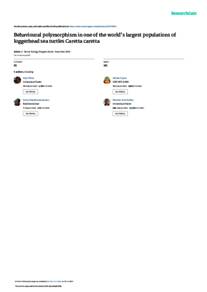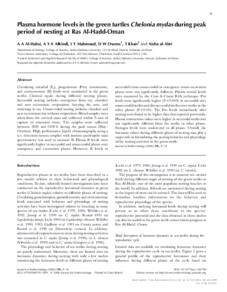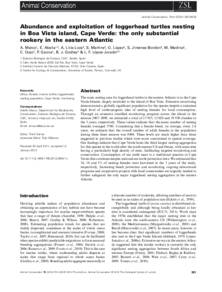Document
Behavioural polymorphism in one of the world's largest populations of loggerhead sea turtles caretta caretta.
Identifier
DOI: 10.3354/meps08767
Contributors
Al-Saady, Salim., Author
Broderick, Annette C., Author
Coyne, Michael S., Author
Papathanasopoulou, Nancy., Author
Godle, Brendan J., Author
Publisher
Inter-Research.
Gregorian
2010-11
Language
English
Subject
English abstract
To aid management and conservation of widely distributed marine vertebrate species, it is necessary to have a knowledge and understanding of their spatial ecology. We tracked 10 adult female loggerhead turtles Caretta caretta from Masirah Island, Sultanate of Oman, which hosts one of the world's largest breeding aggregations. Transmitters were specifically deployed early in the nesting season to enable tracking throughout the internesting and post-nesting habitats. Turtles displayed a dichotomy in behaviour during the internesting period, with 6 remaining close to Masirah Island and the others undertaking circuitous oceanic loops, hundreds of kilometres in length. This behaviour did not appear to be related to body size. Tracking-derived minimum clutch frequency was on average (± SD) 4.8 ±1.2 nests (n = 8 ind.). Post-nesting migrations revealed a propensity towards long-term utilisation of oceanic habitats in the region between Socotra Island (Yemen) and the mainland of Yemen/Oman, with 76 ± 15.4% of time spent in oceanic habitat (n = 8 ind.). The spatial footprint of our tracked turtles was found to be far less than that of a similar number of turtles that were tagged later in the same season (from a separate unpublished study) and from long-distance returns of flipper tags. The spatial and temporal sub-structuring of the population highlights the need for more comprehensive tracking projects, with deployments across the breeding season in multiple years, in order to obtain reliable estimations of high-use foraging habitats of widely dispersed marine vertebrates. Variation in behaviour patterns suggests the need for diverse conservation measures.
Member of
ISSN
0171-8630
Resource URL
Category
Journal articles




